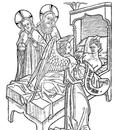A cacophony of voices from radical feminists and ultra conservatives resounds in this compendium of essays on father absence or fatherlessness in America. Lost Fathers: The Politics of Fatherlessness in America is Cynthia Daniels’ attempt to harmonize the dialogue and debate surrounding the economic, political, and cultural concepts of “father” based on what she identifies as the three fundamental points of the controversy: “What is fatherlessness?”, “Does fatherlessness matter?”, and “What is a father?” In her introduction, Daniels claims that the purpose of her work is to generate “more heat and light” concerning the social questions surrounding fatherlessness in order to come closer to “possible solutions.” The following review highlights the main arguments of the nine essays and offers an evaluation of the work taken as a whole.
The social sciences represented in this work take as their starting point the controversy surrounding fatherlessness today (i.e., the 1990s). The controversy, it seems, is really about whether or not absent fathers are a matter for social concern. All agree that fatherlessness has an effect on children and men and women; however, they are not univocal that the effect is negative, nor do they agree on what problems arise from fatherlessness or what actual solutions to it might be. “Conservative” voices claim that the controversy demands a renewed emphasis on marriage and a return to traditional family values; “liberal” voices celebrate emerging and varied expressions of family life that require intense involvement on the part of government institutions in defending the equality of women, legitimizing alternative family relationships, and taking a leading role in the education and welfare of children.
David Popenoe in “Life Without Father” and Maggie Gallagher in “Father Hunger” reflect on the traditional notion of fatherhood, rooted in marriage, where otherwise promiscuous men were tamed, found a bonding agent in the person of their wife, and cared for the offspring they were assured were theirs. Fatherhood, cast in these terms, forms the underpinnings of a stable society and is an institution which governments have a genuine interest in preserving.
Without this structure, Popenoe laments, a whole host of social ills arise including teen violence, teen pregnancy, and child abuse. Fathers, he claims, are the best role models for their sons and the most important male figures in their daughters’ lives. In addition, without a father in the family, the instance of child abuse rises in response to the increased environmental, psychological and emotional vulnerability of children. In addition, unwed men can be a danger to themselves as well as society. They have a greater propensity for promiscuity and crime as well as despondency and depression. Popenoe’s suggested solution is the reestablishment of marriage and fatherhood through legal and economic reforms that protect and encourage the stability of marriage and family life. Though Sara McLanahan’s solutions may differ to those suggested by Popenoe, his conclusions are ratified by the social science research she presents in her essay, “Growing up Without a Father.”
Maggie Gallagher agrees with Popenoe on the negative effects of fatherlessness on children. However, in “Father Hunger” she focuses on the personal dimension of how children articulate their physical, psychological, and emotional desire for a father which is not simply accidental but seems to be a defining characteristic of human nature. “For most children of divorce, domicile is destiny: Only one-third of all children living apart from their fathers get to see their dads as often as once a week…. This is the first generation of American kids who must face not the sad loss of death but the brutal knowledge that other things are more important to their fathers than they are” (pp. 167ff). For Gallagher, marriage needs to be held up as a good, economically rewarded, and protected by legislation, because the norms and mores of a culture of fatherhood are what bind men to their children.
New models of “father” that are not reducible to sexual difference emerge in “Dada-ism in the 1990s.” Judith Stacey claims that culture needs to wean itself from the childish notion of Dada, and drop the baby talk about fatherlessness. For Stacey, the claims of Dadaism resulted in the Promise Keepers movement, the Million Man March, Dan Quayle’s criticism of Murphy Brown, and New Right in politics with pro-family leaders. Pro-family, for Stacey, means restorationism, like that described by Popenoe and Gallagher, which imposes a rigid gender code of post-feminist hostility, inflammatory nostalgia, and chauvinism. Restorationist principles include upholding the sanctity of marriage as the foundation for a successful society that promotes the interests of children, and promoting responsible fatherhood and motherhood.
Stacey espouses the view that this kind of structure is not only vanishing from our culture, but that families do not need the structure of mother, father, or marriage. “The quality of any family’s relationships and resources readily trumps its formal structure or form.” The infatuation with fatherlessness, she claims, is a scapegoat for dealing with the real fears of engagement with the imperfections of humanity and the inability to come to terms with the fact that fathers are not a “pie in the sky” ideal that, if restored, will solve all our social ills. Stacey claims that there should be political neutrality regarding the structure of the family and that more attention should be devoted to the renovation of economic policy in which the “incompatablity of paid work and parenting in the United States is likely the single most crucial source of fatherlessness in America.”
Together, the voices of Lisa Dodson, “‘This River Runs Deep’: Father Myths and Single Mothers in Poor America”; Jean Bethke Elshtain, “The Lost Children”; and Dorothy Roberts, “The Absent Black Father,” harmonize around the theme that single mothers raising families are the poorest people in America. Their varied perspectives on single mothers, teen pregnancy, and black single mothers consider the social and economic implications of fatherlessness for women and children. Their claims are that not all women are radical feminists and not all men are cads, but that there are insurmountable pressures which, in many cases, result in the undesired outcome of fatherless families. The uncoupling of sex from marriage in the 1960s, no fault divorce, the loss of a family wage, the policies of a racially motivated limited government that would renounce a robust welfare state that cares for poor fatherless families, encouraging black men to return home without healing the disease of racism, all contribute to the phenomenon of fatherlessness.
In the opening essay of the book, “The History and Politics of Fatherhood,” Robert L. Griswold seeks to clarify and challenge assumptions made by traditionalists and feminists concerning the role of fatherhood in America. He contends that “Conservatives and liberals agree that for most of American history men had a secure place within their families, but the meaning they attach to this security is quite different.” Griswold examines three major nostalgic assumptions: the co-residence of fathers with their children, paternal availability, and the notion of the “good-enough” father.
That fathers lived in the same domicile as their children more in the past than they do presently is an incontrovertible fact; yet Griswold offers weighty historic and bioevolutionary evidence to indicate how fundamentally the culture of the home is running “counter not only to America’s prior history but to the evolution of the species itself…. Until recently, American culture for both historical and bioevolutionary reasons powerfully endorsed the father-child bond, and what we have today is a unique challenge to this endorsement.” While this bond is being challenged, Griswold also challenges the notion that fathers were more available to their children in the past and that they were good enough, in the sense that they knew and fulfilled their role as providers and examples. His claim rests on data from the early 20th century which indicates that, as a result of the industrial revolution and two world wars, fathers were neither available nor “good enough.” Despite the radical changes to the social and cultural notion of “father,” history rules out any misplaced sense of nostalgia in the Ozzie and Harriet depiction of family life.
While the social science research is dated, and many of the cultural references will not be recalled by some current readers, the book is worth an overview. The work’s major flaw is that it does not capture the meaning of father; rather it simply represents a cacophony of voices in the reduction of fatherhood. Despite her attempt to suggest solutions to the problem of fatherlessness, neither Daniels nor her contributors adequately address the definition of “father.” In, other words, for all the time spent giving voice to the problems that come from fatherlessness, the meaning or nature of a father is never defined as a value. Fatherhood remains a secondary concern to the political, social, and cultural ills resulting from fatherlessness. Even those who would be supporters of restored or found fathers tardily approach the question of the value of fatherhood, and then only from the perspective of creating social stability.
When I think “father,” it is my own father who springs to mind first. This means that my understanding of the term “father” will already assume a personal relationship. Even children who do not know their fathers wish to know who they are. This reflection, regardless of whether my relationship with my father was good or bad, or how much he was present in my life, already brings me to the question of acknowledgment of the source of my own existence. And this may, for many people, require a great deal of personal healing. But it is irrefutable that, before the gift of stability, before being an economic value for the family, my father begat me. My life is a gift because of him, and his life is a gift because of his father before him, and so on. Rather than simply reducing the role of fathers to their social and economic contributions, even with the good that might be, we do better to begin with the reality that fathers are superfluous in the sense that they are gratuitous. They are more than what is required; they go beyond themselves and exceed their own limitations by giving life to their children. Fatherlessness, then, understood on the part of all the contributors of this work, even though we may agree with some of their proposals, is steeped in a rejection of fatherhood articulated in Robert Griswold’s conclusion: “Above all, we must continue to reflect on a problem central to liberal theory and modern individualism: how to balance the self-interest of adults with the needs of children.”
Fatherhood is a gift which needs to be protected and it is in the very real interests of the state to establish pro-family policies and promote fatherhood. But social reforms will not, in themselves, bring about the good that is required for the return of the “father.” What is required, first, is acknowledgement and a sense of gratitude for the gift and mystery that is expressed in fatherhood.



